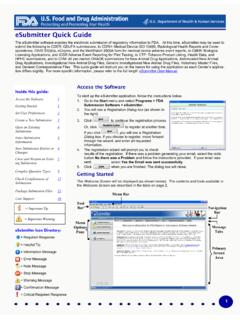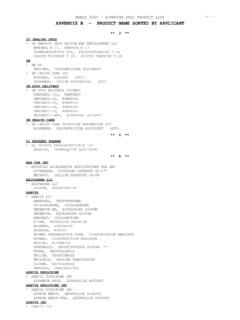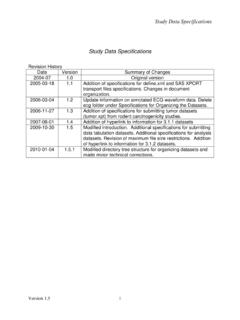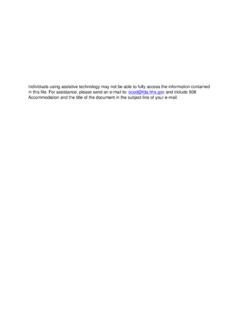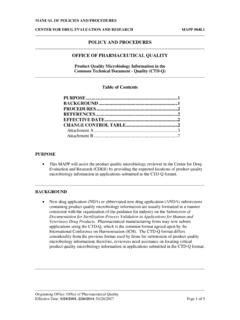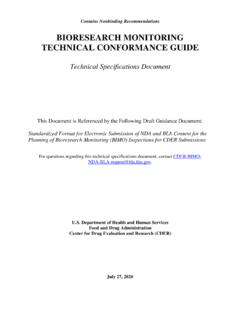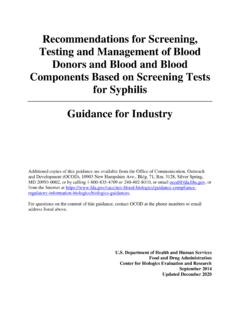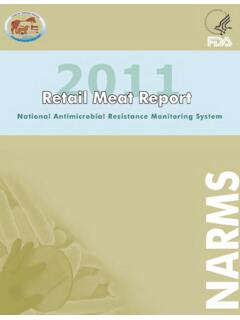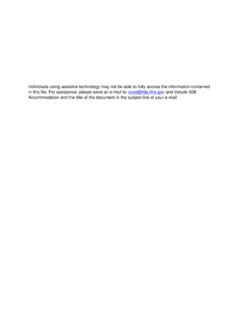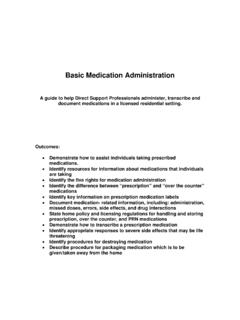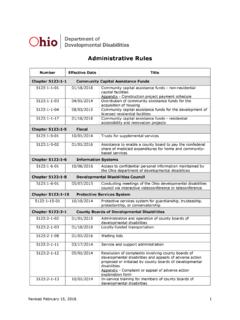Transcription of Repackaging of Certain Human Drug Products by …
1 Repackaging of Certain Human drug Products by pharmacies and Outsourcing Facilities Guidance for Industry Department of Health and Human Services Food and drug Administration Center for drug Evaluation and Research (CDER) January 2017 Compounding and Related Documents Repackaging of Certain Human drug Products by pharmacies and Outsourcing Facilities Guidance for Industry Additional copies are available from: Office of Communications Division of drug Information, WO51, Room 2201 Center for drug Evaluation and Research Food and drug Administration 10903 New Hampshire Ave., Silver Spring, MD 20993 Phone: 301-796-3400; Fax: 301-847-8714 Department of Health and Human Services Food and drug Administration Center for drug Evaluation and Research (CDER) January 2017 Compounding and Related Documents Contains Nonbinding Recommendations TABLE OF CONTENTS I.
2 INTRODUCTION AND 1 II. BACKGROUND .. 2 A. Repackaging , Generally .. 2 B. Regulatory Framework for III. 4 A. General Policy .. 4 B. Establishment Registration and drug Contains Nonbinding Recommendations Repackaging by entities that are not State-licensed pharmacies , Federal facilities, or outsourcing facilities ( , repackers registered with FDA under section 510 of the FD&C Act). Removing a drug product from the original container at the point of care ( , patient s bedside) for immediate administration to a single patient after receipt of a valid patient-specific prescription or order for that patient ( , drawing up a syringe to administer directly to the patient).
3 FDA does not consider this to be Repackaging , for purposes of this guidance document. Upon receipt of a valid patient-specific prescription, a licensed pharmacy removing from one container the quantity of non-sterile drug products5 ( , oral dosage forms) necessary to fill the prescription and placing it in a different container to dispense directly to the patient. Investigational new drugs being studied under an investigational new drug application. This guidance does not alter FDA s existing approach to regulating investigational new drugs. In general, FDA s guidance documents do not establish legally enforceable responsibilities. Instead, guidances describe the Agency s current thinking on a topic and should be viewed only as recommendations, unless specific regulatory or statutory requirements are cited. The use of the word should in Agency guidances means that something is suggested or recommended, but not required.
4 II. BACKGROUND A. Repackaging , Generally FDA regards Repackaging as the act of taking a finished drug product from the container in which it was distributed by the original manufacturer and placing it into a different container without further manipulation of the Repackaging also includes the act of placing the contents of multiple containers ( , vials) of the same finished drug product into one container, as long as the container does not include other ingredients. If a drug is manipulated in any other way, including if the drug is reconstituted, diluted, mixed, or combined with another ingredient, that act is not considered Repackaging is performed by a range of entities, including pharmacies and other facilities that specialize in Repackaging drug Products . FDA is aware that Repackaging is done for a variety of 5 For purposes of this guidance, a sterile drug is a drug that is intended for parenteral administration, an ophthalmic or oral inhalation drug in aqueous format, or a drug that is required to be sterile under Federal or State law.
5 6 For example, if tablets are removed from a blister pack and placed into a different container, that would be Repackaging . However, if the blister packs containing tablets are placed into a different container for later use (without opening the individual blister packs), that would not be Repackaging . 7 This guidance does not apply to the compounding of drug Products . Compounding is addressed in other guidance documents. See, for example, the guidances Pharmacy Compounding of Human drug Products Under Section 503A of the Federal Food, drug , and Cosmetic Act and For Entities Considering Whether to Register as Outsourcing Facilities Under Section 503B of the Federal Food, drug , and Cosmetic Act. 2 Contains Nonbinding Recommendations reasons including: to meet the needs of specific groups of patients ( , pediatric patients or patients receiving drugs for ophthalmic use) who require smaller doses of approved sterile drug Products that may not be available commercially; to reduce medication errors associated with drawing up a dose from a vial at the point of patient care; to reduce the availability of drug Products that could be abused when controlled substances are left over in a vial after a dose is drawn out; to provide a particular sized container to fit into a particular device to administer the drug (such as a particular pain medication pump); for convenience for the practitioner administering an injection to a patient.
6 To reduce waste and conserve drug supplies; and in some cases to reduce cost. Some repackagers repackage both sterile and non-sterile drug Products . Examples of Repackaging include tablets and capsules that are repackaged from large containers into smaller containers or blister packs, and creams and lotions are sometimes purchased in bulk and repackaged into smaller tubes or containers. As part of the drug application review and approval process, FDA evaluates the container closure system and the packaging into which the drug will be placed, as well as the conditions under which the drug will be packaged. The container closure system and packaging can affect the quality of the drug product when it is on the market. In particular, during the approval process, FDA reviews whether the container closure system and the packaging are appropriate for maintaining the stability of the drug product through its expiration date, as long as the container-closure and package are not breached, and the drug is stored according to the conditions specified in the application.
7 For drug Products required to be sterile, FDA also considers whether the container closure system and packaging are adequate to ensure that the drug product will remain sterile until its expiration date, as long as the container closure is not breached and the drug product is stored appropriately. When a drug product is repackaged, its characteristics may change in ways that have not been evaluated during the FDA approval process and that could affect the safety and efficacy of the drug product . Improper Repackaging of drug Products can cause serious adverse events. Of particular concern is Repackaging of sterile drug Products , which are susceptible to contamination and degradation. For example, failure to properly manipulate sterile drug Products under appropriate aseptic conditions could introduce contaminants that could cause serious patient injury or death. Repackaging practices that conflict with approved product labeling could result in drug product degradation and adverse events associated with impurities in the product or lack of efficacy because the active ingredient has deteriorated.
8 B. Regulatory Framework for Repackaging Repackaged drug Products are generally not exempt from any of the provisions of the FD&C Act related to the production of drugs. For example, repackaged drug Products are generally subject to the premarket approval, misbranding, adulteration, and drug supply chain security provisions of the FD&C Act, including section 505 (concerning new drug applications),8 section 502(f)(1) 8 But see v. Kaybel, 430 1346 (3d Cir. 1970) (holding that Repackaging of approved Enovid (estrogen) tablets from large bottles into small bottles did not require pre-approval under section 505 of the FD&C Act). 3 Contains Nonbinding Recommendations (concerning labeling with adequate directions for use), section 501(a)(2)(B) (concerning current good manufacturing practice (CGMP)), and section 582 (concerning drug supply chain security).
9 Drugs that are repackaged are not subject to sections 503A and 503B of the FD&C Therefore, drug Products repackaged by State-licensed pharmacies , Federal facilities, or outsourcing facilities are not eligible for the exemptions provided under those sections. In this guidance, FDA describes the conditions under which it does not intend to take action regarding violations of Certain requirements of the FD&C Act, in the context of drug Repackaging . III. POLICY A. General Policy10 As discussed above, repackaged drug Products are generally subject to the adulteration, misbranding, and approval provisions of the FD&C FDA does not intend to take action for violations of sections 505, 502(f)(1), and 582 if a State-licensed pharmacy, a Federal facility, or an outsourcing facility repackages drug Products in accordance with the conditions described below, and any applicable , 13 In addition, FDA does not intend to take action for violations of section 501(a)(2)(B) of the FD&C Act if the drug product is repackaged by a State-licensed pharmacy or a Federal facility in accordance with the conditions described below, and any applicable The conditions referred to in the preceding paragraph are as follows.
10 9 Section 503A of the FD&C Act exempts compounded drug Products from sections 505, 502(f)(1), and 501(a)(2)(B) of the FD&C Act provided Certain conditions are met, including that the drug product is compounded pursuant to a valid prescription for an individually identified patient from a licensed practitioner. The drug Quality and Security Act added a new section 503B to the FD&C Act. Under section 503B(b), a compounder can register as an outsourcing facility with FDA. drug Products compounded by or under the direct supervision of a licensed pharmacist in an outsourcing facility qualify for exemptions from the FDA approval requirements in section 505 of the FD&C Act, the requirement to label drug Products with adequate directions for use under section 502(f)(1) of the FD&C Act, and the drug Supply Chain Security Act requirements in section 582 of the FD&C Act, if the conditions in section 503B are met. drug Products compounded in outsourcing facilities are not exempt from CGMP requirements under section 501(a)(2)(B).

